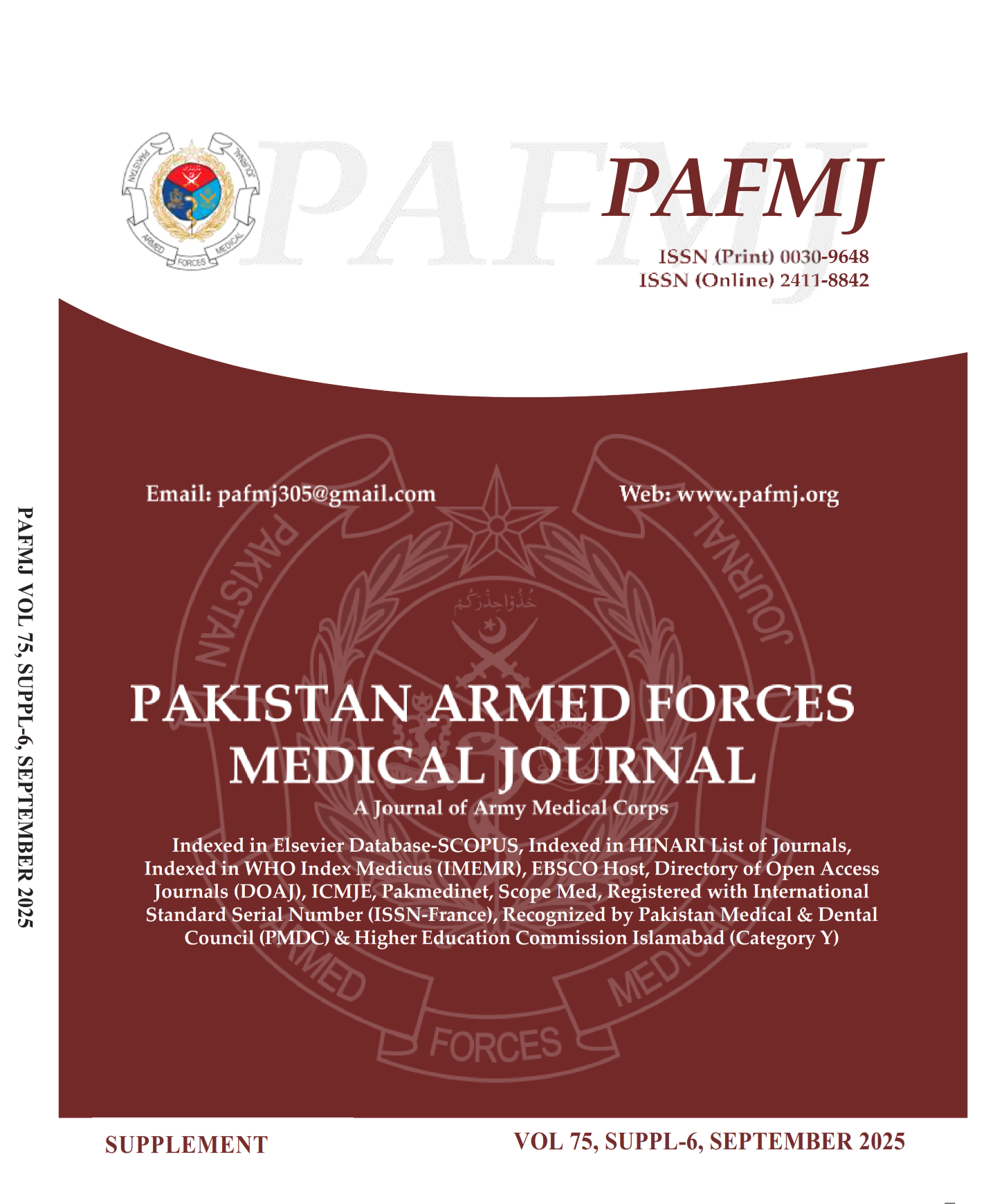Induction Response in Patients of Classical Hodgkin Lymphoma of Pediatric Age Group as Asseseed by CT Scan Post Chemotherapy Induction
DOI:
https://doi.org/10.51253/pafmj.v75iSUPPL-6.12117Keywords:
Chemotherapy, CT scan, Hodgkin, Induction, PET scan, ResponseAbstract
Objective: To assess the induction response to chemotherapy as adequate or inadequate using CT (computed tomography) scan texture analysis parameters in pediatric patients of classical Hodgkin lymphoma when compared with the gold standard PET findings.
Study Design: Prospective longitudinal study
Place and Duration of Study: Pediatrics department of Combined Military Hospital, Rawalpindi Pakistan, from Jan 2023 to Dec 2023.
Methodology: After the histopathological diagnosis was confirmed, Positron emission tomography and Computed tomography scans were done in all patients before the start and the end of two cycles of chemotherapy and response to treatment was compared using imaging changes before and after the procedure. Primary variables measured were early response assessment (ERA) by adequate and inadequate response to chemotherapy assessed by Computed tomography scan findings compared to those of Positron emission tomography scan results. Sensitivity and specificity was also calculated for Computed tomography findings versus Positron ......
Results: Radiological lesion analysis by independent consultants for PET and CT scan for the tumors showed that patients showed adequate early response in 94(78.3%) cases in PET scan results versus 59(49.2%) cases on CT scan findings. Similarly inadequate response was labelled in 26(21.7%) cases when assessed by PET scan and 61(50.8%) when labeled after assessment of texture analysis of tumors on CT scan (p=0.034). The sensitivity of CT scan in detecting adequate and inadequate response .. ..
Conclusion: We conclude that CT scan shows low sensitivity and specificity in detecting adequate and inadequate response to early stage chemotherapy in pediatric Hodgkin Lymphoma with ...
Downloads
References
1. Lo AC, Dieckmann K, Pelz T, Gallop‐Evans E, Engenhart‐Cabillic R, Vordermark D, et al. Pediatric classical Hodgkin lymphoma. Pediatric Blood & Cancer 2021; 68: e28562.
https://doi.org/10.1002/pbc.28562
2. Flerlage JE, Hiniker SM, Armenian S, Benya EC, Bobbey AJ, Chang V, et al. Pediatric Hodgkin lymphoma, version 3.2021. Journal of the National Comprehensive Cancer Network 2021; 19(6): 733-754.
https://doi.org/10.6004/jnccn.2021.0027
3. Ghafoor T. Prognostic factors in pediatric Hodgkin lymphoma: experience from a developing country. Leukemia & Lymphoma 2020; 61(2): 344-350.
https://doi.org/10.1080/10428194.2019.1665666
4. Lundgaard AY, Hjalgrim LL, Rechner LA, Lundemann M, Brodin NP, Joergensen M, et al. The risk of late effects following pediatric and adult radiotherapy regimens in Hodgkin lymphoma. Strahlentherapie und Onkologie 2021; 197: 711-721.
https://doi.org/10.1007/s00066-020-01721-w
5. Kendel NE, Stanek JR, Willen FK, Audino AN. Characterizing age-related differences in Hodgkin lymphoma in children, adolescents and young adults. Pediatric Hematology and Oncology. 2024: 1-10.
https://doi.org/10.1080/08880018.2024.2337627
6. Marks LJ. Improving risk stratification to guide treatment decisions for children, adolescents, and young adults with Hodgkin Lymphoma. Journal of the National Comprehensive Cancer Network 2021; 19(6): 666-668.
https://doi.org/10.6004/jnccn.2021.7041
7. Lee JM, Choi JY, Hong KT, Kang HJ, Shin HY, Baek HJ, et al. Clinical characteristics and treatment outcomes in children, adolescents, and young-adults with Hodgkin's lymphoma: A KPHOG lymphoma working-party, multicenter, retrospective study. Journal of Korean Medical Science 2020; 35(46).
https://doi.org/10.3346%2Fjkms.2020.35.e393
8. Ansell SM. Hodgkin lymphoma: A 2020 update on diagnosis, risk‐stratification, and management. American journal of hematology 2020; 95(8): 978-789.
https://doi.org/10.1002/ajh.25856
9. Spijkers S, Littooij AS, Kwee TC, Tolboom N, Beishuizen A, Bruin MC, et al. Whole-body MRI versus an [18 F] FDG-PET/CT-based reference standard for early response assessment and restaging of paediatric Hodgkin’s lymphoma: a prospective multicentre study. European Radiology 2021; 31: 8925-8936.
https://doi.org/10.1007/s00330-021-08026-1
10. Abenavoli EM, Linguanti F, Anichini M, Miele V, Mungai F, Palazzo M, et al. Texture analysis of 18F‐FDG PET/CT and CECT: Prediction of refractoriness of Hodgkin lymphoma with mediastinal bulk involvement. Hematological Oncology 2024; 42(2): e3261.
https://doi.org/10.1002/hon.3261
11. Mauz-Körholz C, Landman-Parker J, Balwierz W, Ammann RA, Anderson RA, Attarbaschi A, et al. Response-adapted omission of radiotherapy and comparison of consolidation chemotherapy in children and adolescents with intermediate-stage and advanced-stage classical Hodgkin lymphoma (EuroNet-PHL-C1): a titration study with an open-label, embedded, multinational, non-inferiority, randomised controlled trial. The Lancet Oncology 2022; 23(1): 125-137.
https://doi.org/10.1016/S1470-2045(21)00470-8
12. Taroco MGR, Cuña EG, Pages C, Schelotto M, González-Sprinberg GA, Castillo LA et al. Prognostic value of imaging markers from 18FDG-PET/CT in paediatric patients with Hodgkin lymphoma. Nuclear Medicine Communications 2021; 42(3): 306-614.
https://doi.org/10.1097/MNM.0000000000001337
13. Al-Sharify ZT, Al-Sharify TA, Al-Sharify NT, editors. A critical review on medical imaging techniques (CT and PET scans) in the medical field. IOP Conference Series: Materials Science and Engineering; 2020: IOP Publishing.
https://doi.org/10.1088/1757-899X/870/1/012043
14. Lewis WD, Lilly S, Jones KL. Lymphoma: diagnosis and treatment. American family physician 2020; 101(1): 34-41.
15. De Vries S, Schaapveld M, Janus CP, Daniëls LA, Petersen EJ, van der Maazen RW, et al. Long-term cause-specific mortality in Hodgkin lymphoma patients. JNCI: Journal of the National Cancer Institute 2021; 113(6): 760-769.
https://doi.org/10.1093/jnci/djaa194
16. Al Tabaa Y, Bailly C, Kanoun S. FDG-PET/CT in lymphoma: where do we go now? Cancers 2021; 13(20): 5222.
https://doi.org/10.3390/cancers13205222
17. Yassin A, El Sheikh RH, Ali MM. PET/CT vs CECT in assessment of therapeutic response in lymphoma. Egyptian Journal of Radiology and Nuclear Medicine 2020; 51: 1-11.
https://doi.org/10.1186/s43055-020-00353-5
18. Trotman J, Barrington SF. The role of PET in first-line treatment of Hodgkin lymphoma. The Lancet Haematology 2021; 8(1): e67-e79. https://doi.org/10.1016/S2352-3026(20)30357-4
Downloads
Published
Issue
Section
License
Copyright (c) 2025 Haider Ali Awan Awan, Waqas Ahmed, Shakeel Ahmed, Sumbal Malik, Bilal Akhlaq, Rehan Mehmood

This work is licensed under a Creative Commons Attribution-NonCommercial 4.0 International License.















